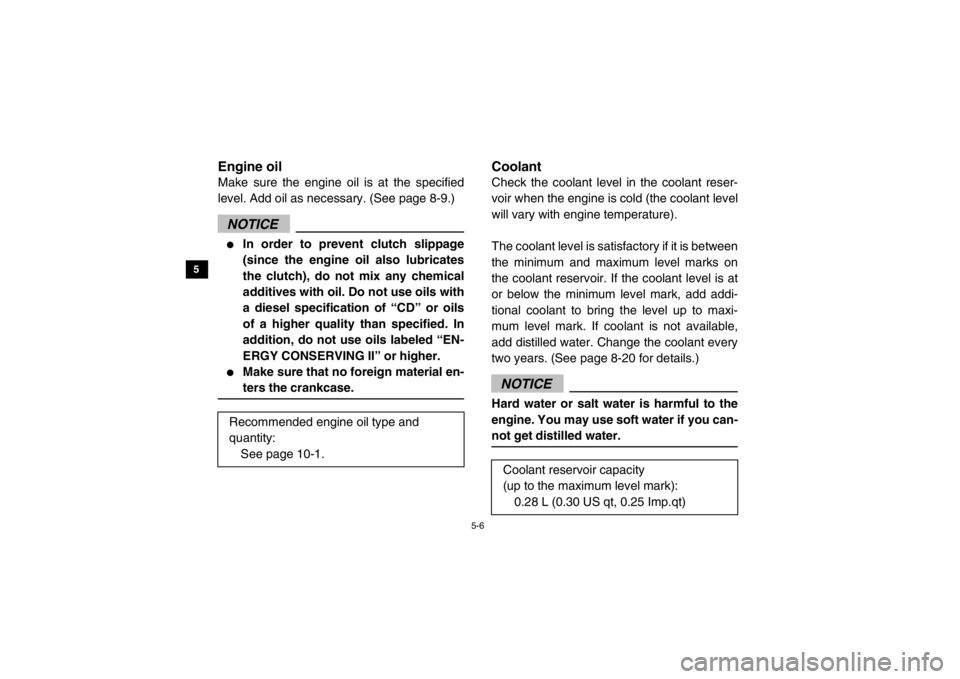Page 34 of 182
4-2
4
5
6
7
8
9
10
11
12
13
14
EVU00150Indicator lights and warning lights1. On-Command differential gear lock indicator light “DIFF. LOCK”
2. Low-range indicator light “L”
3. High-range indicator light “H”
4. Neutral indicator light “N”
5. Reverse indicator light “R”
6. Parking brake indicator light “ ”
7. On-Command four-wheel-drive/differential gear lock indicator “ ”/“ ”
8. Engine trouble warning light “ ”
9. Coolant temperature warning light “ ”
10. Electric Power Steering warning light “EPS” 1. Helmet indicator light “ ”
2. Seat belt indicator light “ ”
EVU01140Low-range indicator light “L”
This indicator light comes on when the drive
select lever is in the “L” position.EVU01150High-range indicator light “H”
This indicator light comes on when the drive
select lever is in the “H” position.
356421
7
809
DIFF.
LOCK
21
1XP7C_EE.book Page 2 Monday, June 9, 2014 5:17 PM
Page 36 of 182
4-4
4
5
6
7
8
9
10
11
12
13
14
5B410002Coolant temperature warning light “ ”
If the coolant temperature reaches a specific
level, this light comes on to warn that the cool-
ant temperature is too hot. If the light comes
on during operation, stop the engine as soon
as it is safe to do so and allow the engine to
cool down for about 10 minutes.
(See page 8-58.)
The electrical circuit of the warning light can
be checked by turning the key to “ ” (on). If
the warning light does not come on initially
when the key is turned to “ ” (on), or if the
warning light remains on, have a Yamaha
dealer check the electrical circuit.
NOTICE●
The engine may overheat if the vehicle
is overloaded. If this happens, reduce
the load to specification.
●
After restarting, make sure that the
warning light is out. Continuous use
while this warning light is on may
cause damage to the engine.
1XP7C_EE.book Page 4 Monday, June 9, 2014 5:17 PM
Page 68 of 182

5-6
5
6
7
8
9
10
11
12
13
14
EVU00410Engine oilMake sure the engine oil is at the specified
level. Add oil as necessary. (See page 8-9.)NOTICE●
In order to prevent clutch slippage
(since the engine oil also lubricates
the clutch), do not mix any chemical
additives with oil. Do not use oils with
a diesel specification of “CD” or oils
of a higher quality than specified. In
addition, do not use oils labeled “EN-
ERGY CONSERVING II” or higher.
●
Make sure that no foreign material en-
ters the crankcase.
EVU00420CoolantCheck the coolant level in the coolant reser-
voir when the engine is cold (the coolant level
will vary with engine temperature).
The coolant level is satisfactory if it is between
the minimum and maximum level marks on
the coolant reservoir. If the coolant level is at
or below the minimum level mark, add addi-
tional coolant to bring the level up to maxi-
mum level mark. If coolant is not available,
add distilled water. Change the coolant every
two years. (See page 8-20 for details.)NOTICEHard water or salt water is harmful to the
engine. You may use soft water if you can-
not get distilled water.
Recommended engine oil type and
quantity: See page 10-1.
Coolant reservoir capacity
(up to the maximum level mark):0.28 L (0.30 US qt, 0.25 Imp.qt)
1XP7C_EE.book Page 6 Monday, June 9, 2014 5:17 PM
Page 75 of 182

6-2
1
2
3
4
56
7
8
9
10
11
12
13
14
Each full-throttle acceleration sequence
should be followed with a substantial rest pe-
riod for the engine, by cruising at lower r/min
so the engine can rid itself of the temporary
build-up of heat. If any abnormality is noticed
during this period, consult a Yamaha dealer.
0–10 hours:
Avoid continuous operation above 1/2-throt-
tle. Allow a cooling-off period of 5 to 10 min-
utes after every hour of operation. Vary the
speed of the vehicle from time to time. Do not
operate it at one set throttle position.
10–20 hours:
Avoid prolonged operation above three-quar-
ter throttle.
After break-in:
The vehicle may now be operated normally.
5B410007Starting the engine1. Turn the key to “ ” (on).NOTICEThe coolant temperature warning light and
engine trouble warning light should come
on, then go off.
The EPS warning light should come on,
then go off when the engine is started.
If a warning light does not go off, see page
4-2 for the corresponding warning light
circuit check.2. Apply the brake pedal.
3. Shift the drive select lever into the neutralposition.
●
When the drive select lever is in the
neutral position, the neutral indicator
light should come on. If the neutral in-
dicator light does not come on, ask a
Yamaha dealer to inspect the electric circuit.
1XP7C_EE.book Page 2 Monday, June 9, 2014 5:17 PM
Page 131 of 182
8-21
1
2
3
4
5
6
78
9
10
11
12
13
14
Changing the coolant
The coolant must be changed by a Yamaha
dealer at the intervals specified in the periodic
maintenance and lubrication chart.
Adding water instead of coolant lowers the
antifreeze content of the coolant. If water is
used instead of coolant, have a Yamaha deal-
er check the antifreeze content of the coolant
as soon as possible.
The radiator fan is automatically switched on
or off according to the coolant temperature in
the radiator.NOTICEMix antifreeze with distilled water only.
However, if distilled water is not available,
soft water may be used for refilling.If your vehicle overheats, see page 8-58 for
instructions.
EVU00740Axle bootsCheck the axle boots for holes or tears.
If any damage is found, have them replaced
by a Yamaha dealer.1. Front axle boot (× 2 each side)
1
1
1XP7C_EE.book Page 21 Monday, June 9, 2014 5:17 PM
Page 177 of 182

10-5
1
2
3
4
5
6
7
8
910
11
12
13
14
Bulb voltage, wattage
× quantity:
Headlight:
12 V, 35.0/35.0 W × 2
Tail/brake light:
12 V, 5.0/21.0 W × 2
Neutral indicator light: LED
Reverse indicator light: LED
Coolant temperature warning light:
LED
Engine trouble warning light: LED
Parking brake indicator light: LED
On-Command four-wheel-drive/differential gear lock indica-
tor: LCD
High-range indicator light:
LED
Low-range indicator light: LED
Differential gear lock indicator light: LED
EPS warning light:
LED
Helmet/Seat belt indicator light: 14 V, 0.85 W × 2Fuses:Main fuse:
40.0 A
Fuel injection system fuse: 10.0 A EPS fuse:
40.0 A
Headlight fuse: 15.0 A
Signaling system fuse:
10.0 A
Ignition fuse: 10.0 A
Auxiliary DC jack fuse: 10.0 A
Backup fuse:
10.0 A
Four-wheel-drive motor fuse: 10.0 A
Radiator fan motor fuse: 25.0 A
For Europe only
The figures quoted are emission levels and
are not necessarily safe working levels. Whilst
there is a correlation between the emission
and exposure levels, this cannot be used reli-
ably to determine whether or not further pre-
cautions are required.
Factors that influence the actual level of expo-
sure of work-force include the characteristics
of the work room, the other sources of noise,
etc. i.e. the number of machines and other ad-
1XP7C_EE.book Page 5 Monday, June 9, 2014 5:17 PM